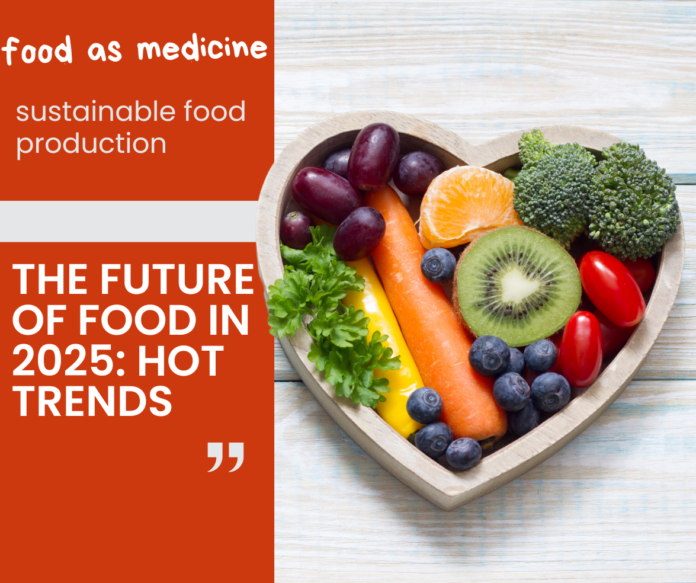Introduction
At this juncture of food innovation and sustainability, the future for food is bright and bounding. We imagine technology meeting health concerns, environmental concerns, and cultural shift realigning the paradigm in the way we grow food, prepare it, and eat it in 2025.
This article covers some of the key trends that will shape the face of food over the next few years, describing what the consumer will be expected to do, what kind of challenges they face, and how diets and life will change.
Trend 1: ecofood production
From a buzzword in food, sustainability has grown into a movement. This upward trend in the production of sustainable food is likely to go up in 2025. Therefore, sustainability would be propelled toward regenerative agriculture that emphasizes restoration of soil health, increased biodiversity, and reduced carbon footprints.
Point key:
Regenerative Agriculture: Farmers will reduce the disturbance/ erosion in soils by practicing crop rotation, cover cropping, and practicing reduced or no-till methods.
This in turn will add to an increase in production in urban cities, with more fresh produce being grown on small spaces with minimal environmental impacts.
Herbivorous Diets: The population is going to become greener because of the growing demands for healthier diets and lesser environmental harm.
Trend #2: Technologisation of Food Production
A new wave of reproduction, if one may call it that, is in food technology-something nobody thought of. Thus, by 2025, tectonic shifts in food security can be noticed: lab-grown meat and artificial intelligence-driven agricultural practices.
Key Points:
Clean meat is one of those alternative meats that will be accepted into the mainstream and shows a perfectly sustainable alternative to traditional livestock farming.
Precision farming will involve the use of drones, sensors, and AI to monitor crop health for yield optimization-reducing overall levels of waste and resource usage.
With blockchain, consumers will be able to track the foods to their real origin.
Trend 3: Personal nutrition
Nutritional knowledge will shift from the general approach to personalized nutrition; dietary recommendations would, for that matter, be designed for each particular need. By 2025, the genetic test and nutrition science would have developed in a way to enable the consumer to make more informed choices regarding the food he/she is consuming.
Key Points: It will provide consumers with information they may need to know on DNA-based diets, including macronutrient ratio and even food sensitivity.
Smart Supplements: Supplements would get tailored for the demand of nutritional needs, as health-related data would be available in each consumer profile.
Health Monitoring Devices: Wearables are pieces of technology which will really enable one to monitor health constantly, hence offering real-time feedback on the effects of diet on health.
Trend 4: Food as Medicine
The growth in awareness of the interplay between food and health introduces a new era: that of “medicine as food.” A number of integrations of the health care system in nutrition include, among others, a more active role for diet in disease prevention and management by the year 2025.
Key Points:
Nutritional therapy: The health professionals will begin to apply nutritional therapy in the treatment programs, and for now, they will have an idea where the person’s health problem highly contributes to the diet of a person. Functional Foods: Foods that can be used to improve other health conditions rather than for basic nutrition, including prebiotic and probiotic gut health and enrichment foods. Public Health Campaigns: It is highly needed that the government initiates healthy eating through various public health programs for these people to show the value of diets.
Trend 5: Plant-Based Proteins Heat
Up This means that the amount of proteins needed will keep on increasing with an increase in population. By the year 2025, therefore, there will be a need for alternative proteins in answering the demand while addressing environmental concerns associated with traditional animal farming.
Key Points:
Insect Protein: Due to its huge embrace as a sustainable option, this insect-based protein is highly nutritious and requires very minimal resources to reproduce.
Aquaculture will imply clean seafood, mainstreamed. Lab-grown seafood will be a practical alternative to overfishing. The true gourmet will have seafood, not at the cost of hurting the living resources of the ocean.
Pea and Bean Proteins: As diets should or are desired by consumers to be more ‘green’, peas and beans will continue a big factor in the development of plant-based protein products.
Conclusion:
There is promise and innovation aplenty in the futures of food as we forge ahead on complex, convergent paths: sustainability, technology, and health. We can expect giant leaps in food production practices, personalized nutrition, and food as a key determinant of health by the year 2025.
It is us, the consumer, who will be empowered in using our choices at discretion to advance forces of change toward the more sustainable and healthier food system for future generations.
FAQs
What follows are some sustainable practices in food production.
Some key practices burgeo[ned in the heart of sustainability include regenerative farming, vertical farming, and organic farming.
What is Clean Meat?
Clean meat is cultured from animal cells in the lab; hence, it is a more ‘green’ alternative to conventionally produced meat.
How is personalized nutrition done?
It regards genetic background, health status, lifestyle-and comes up with dietary suggestions based on these.
What are the functional foods?
These foods convey benefits beyond basic nutrition, like fortified foods and probiotics.
What place do alternative proteins take in the future of food?
This will position the team well in supplying the world with its renewable sources of proteins against the increased global demand.
How is technology assisting in food production?
This precision agriculture, combined with drones and AI, will improve yields while waste is kept at a bare minimum.
What does food as medicine mean?
This places the role of diet in health conditions, either preventive or managerial.
Alternative protein sources include the following.
The exploration of insect proteins, lab-grown seafood, and plant-based proteins from peas and beans has been extended. What is urban farming, and what is its future? Farming within cities is being continuously made through vertical farming and hydroponics to maximize space, as well as overall sustainability. What is regenerative agriculture? Agroecology is one of the methodologies of farming concerned with restoration to health through improvement in biodiversity. This raises another question: will in-vitro flesh ever catch up to its more mainstream methods? That is, cultured meat will be more acceptable with increased awareness of sustainability and ethics. Personalised nutrition and health: how does that go about? This will further enable them to make appropriate food choices that will best suit their health needs. What are some benefits derived from the consumption of discussed functional foods? They are beneficial to certain aspects of health, such as gut health and immunity. Where will blockchain technology go further to improve food transparency? In other words, it traces from where their food will be coming from, becoming transparent in the supply chain process. What is the future of plant-based eating? The plant-based food will keep improving in the future years by considering health and environmental concerns. How might public health campaigns address nutrition? They shall spend their time teaching the citizenship healthy eating and the essence of nutrition. What are the different challenges towards sustainable food production? These are challenges in terms of global warming, scarcity of natural resources and technological advancement. How Do Consumers Decide the Future of Food? The consumers can secure the future of food by making practical choices that can inspire the producers to change towards environmentally friendly methods that ensure sustainability. What is an intelligent supplement? Health supplements for target areas-binding for particular needs. Insect protein-to be accepted in the West Yes, this is because awareness of the sustainability of insect protein along with nutritional benefits is believed to rise.





































